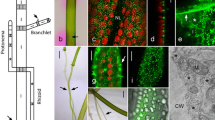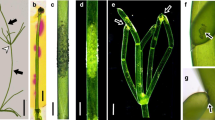Abstract
We have analyzed light induction of side-branch formation and chloroplast re-arrangement in protonemata of the mossCeratodon purpureus. After 12 hr of dark adaptation, the rate of branch formation was as low as 5%. A red light treatment induced formation of side branches up to 75% of the dark-adapted protonema. The frequency of light induced branch formation differed between cells of different ages, the highest frequency being found in the 5th cell, the most distal cell studied from the apex. We examined the effect of polarized light given parallel to the direction of filament growth. The position of branching within the cell depended on the vibration plane of polarized red light. Branch formation was highest when the electric vector of polarized light vibrates parallel to the cell surface and is fluence rate dependent. The positional effect of polarized red light could be nullified to some extent by simultaneous irradiation with polarized far-red light. An aphototropic mutant,ptr116, shows characteristics of deficiency in biosynthesis of the phytochrome chromophore and exhibits no red-light induced branch formation. Biliverdin, a precursor of the phytochrome chromophore, rescued the red-light induced branching when added to the medium, supporting the conclusion that phytochrome acts as photoreceptor for red light induced branch formation. The light effect on chloroplast re-arrangement was also analyzed in this study. We found that polarized blue light induced chloroplast re-arrangement in wild-type cells, whereas polarized red light was inactive. This result suggests that chloroplast re-arrangement is only controlled by a blue light photoreceptor, not by phytochrome inCeratodon.
Similar content being viewed by others
Abbreviations
- B:
-
blue light
- F:
-
flanking position
- FR:
-
far-red light
- H:
-
pol. light, horizontally-vibrating polarized light
- I:
-
intermediate position
- IR:
-
infra-red
- R:
-
red light
- T:
-
top-or-bottom position
- V:
-
pol. light, vertically-vibrating polarized light
- wt:
-
wild type
References
Bittisnich, D. andWilliamson, R.E. 1985. control by phytochrome of extension growth and polarotropism in chloronemata ofFunaria hygrometrica. Photochem. Photobiol.42: 429–436.
Cove, D.J., Quatrano, R.S. andHartmann, E. 1996. The alignment of the axis of asymmetry in regenerating protoplasts of the moss,Ceratodon purpureus is determined independently of axis polarity. Development122: 371–379.
Cove, D.J., Quatrano, R.S. and Hartmann, E. 1997. The morphogenetic gradient determining axis polarity in regenerating protoplasts of the moss,Ceratodon purpureus, involves phytochrome. Plant Cell Environ. (in press).
Ermolayeva, E., Hohmeyer, H., Johannes, E. andSanders, D. 1996. Calcium-dependent membrane depolarisation activated by phytochrome in the mossPhyscomitrella patens. Planta199: 352–358.
Hartmann, E., Klingeberg, B. andBauer, L. 1983. Phytochrome-mediated phototropism in protonemata of the mossCeratodon purpureus BRID. Photochem. Photobiol.38: 599–603.
Hughes, J.E., Lamparter, T. andMittmann, F. 1996. CpPHY2 (PHYCER2), A “normal” phytochrome inCeratodon (Accession No. U56698, PGR 96-067). Plant Physiol.112: 446.
Jenkins, G.I. andCove, D.J. 1983. Phototropism and polarotropism of primary chloronemata of the mossPhyscomitrella patens: responses of the wild-type. Planta159: 432–438.
Kagawa, T. andWada, M. 1996. Phytochrome-and blue light-absorbing pigment-mediated directional movement of chloroplasts in dark-adapted prothallial cells of ternAdiantum as analyzed by microbeam irradiation. Planta198: 488–493.
Kraml, M. 1994. Light direction and polarization.In R.E. Kendrick and G.H.M. Kronenberg, eds., Photomorphogenesis in Plants, 2nd ed., Kluwer Academic Publishers, Dordrecht, pp. 417–445.
Lamparter, T., Esch, H., Cove, D. andHartmann, E. 1997. Phytochrome control of phototropism and chlorophyll accumulation in the apical cells of protonemal filaments of wild-type and an aphototropic mutant of the mossCeratodon purpureus. Plant Cell Physiol.38: 51–58.
Lamparter, T., Esch, H., Cove, D., Hughes, J. andHartmann, E. 1996. Aphototropic mutants of the moss Ceratodon purpureus with spectrally normal and with spectrally dysfunctional phytochrome. Plant Cell Env.19: 560–568.
Lamparter, T., Podlowski, S., Mittmann, F., Schneider-Poetsch, H.A.W., Hartmann, E. andHughes, J. 1995. Phytochrome from protonemal filaments of the mossCeratodon purpureus. J. Plant Physiol.147: 426–434.
Nebel, B.J. 1968. Action spectra for photogrowth and phototropism in protonemata of the mossPhyscomitrium turbinatum. Planta81: 287–302.
Nebel, B.J. 1969. Responses of moss protonemata to red and far-red polarized light: Evidence for disc-shaped phytochrome photoreceptors. Planta87: 170–179.
Schneider-Poetsch, H.A.W., Marx, S., Kolukisaoglu, H.U., Hanelt, S. andBraun, B. 1994. Phytochrome evolution: Phytochrome genes in ferns and mosses. Physiol. Plant.91: 241–250.
Thümmler, F., Dufner, M., Kreisl, P. andDittrich, P. 1992. Molecular cloning of a novel phytochrome gene of the mossCeratodon purpureus which encodes a putative light-regulated protein kinase. Plant Mol. Biol.20: 1003–1017.
Wada, M. 1995. Nuclear behavior during branch formation in a centrifugedAdiantum protonema and the nuclear polarity. J. Plant Res.108: 501–509.
Wada, M., Kanegae, T., Nozue, K. andFukuda, S. 1997. Cryprogam phytochromes. Plant Cell Environ.20: 685–690.
Wada, M. andSugai, M. 1994. Photobiology of fern.In R.E. Kendrick and G.H.M. Kronenberg, eds., Photomorphogenesis in Plants, 2nd ed., Kluwer Academic Publishers, Dordrecht, pp. 783–802.
Winands, A. andWagner, G. 1996. Phytochrome of the green algaMougeotia: cDNA sequence, autoregulation and phylogenetic position. Plant Mol. Biol.32: 589–597.
Yatsuhashi, H., Kadota, A. andWada, M. 1985. Blueand red-light action in photoorientation of chloroplasts inAdiantum protonemata. Planta165: 43–50.
Zurzycki, J. 1980. Blue light-induced intracellular movements.In H. Senger, ed., Blue Light Syndrome, Springer-Verlag, Berlin Heidelberg New York, pp. 30–68.
Author information
Authors and Affiliations
Corresponding author
Rights and permissions
About this article
Cite this article
Kagawa, T., Lamparter, T., Hartman, E. et al. Phytochrome-mediated branch formation in protonemata of the mossCeratodon purpureus . J. Plant Res. 110, 363–370 (1997). https://doi.org/10.1007/BF02524935
Received:
Accepted:
Issue Date:
DOI: https://doi.org/10.1007/BF02524935




